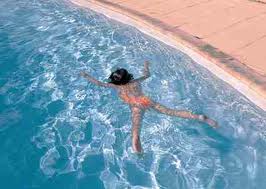- Agency Premiers New Pool Safety Public Service Announcement

The U.S. Consumer Product Safety Commission (CPSC) reports there are about 260 drowning deaths of children younger than 5 each year in swimming pools, and an estimated 2,725 children are treated annually in hospital emergency rooms for pool submersion injuries – mostly in residential pools. CPSC strongly advises that parents use layers of protection around the pool to prevent their children from becoming a drowning victim.
In conjunction with this year’s drowning prevention campaign, CPSC has produced a public service announcement (transcript) to illustrate what happens when a toddler falls into a pool. It vividly demonstrates what you expect to hear and what the reality often sounds like.
“Parents may think that if their child falls in the water, they will hear lots of splashing and screaming, and that they will be able to come to the rescue,” CPSC Acting Chairman Nancy Nord said. “Many times, however, children slip under the water silently. Even people near the pool often report hearing nothing out of the ordinary.”
To reduce the risk of drowning, CPSC recommends adopting layers of protection, including physical barriers, such as a fence with self-closing, self-latching gates completely surrounding pools to prevent unsupervised access by young children. If the house forms a side of the barrier, use alarms on doors leading to the pool area or a power safety cover over the pool.
It is important to always be prepared for an emergency by having rescue equipment and a phone near the pool. Also, all parents who own pools should learn cardiopulmonary resuscitation (CPR)
“No one layer of protection is foolproof to prevent drowning in pools,” said Nord. “Use as many layers of protection as possible. Multiple barriers and constant supervision are essential to protecting children.”
Last year, CPSC highlighted the growing dangers of the popular inflatable or portable pools, which range in size from small kiddie pools to pools up to 4-feet deep and 18-feet wide. Between 2004 and 2006, CPSC received 47 reports of deaths of children related to inflatable pools.
Large inflatable pools are relatively inexpensive – large pools with water filters can cost under $200. They often have slanted or flexible sides, which make it easier for children to climb into the pool even without a ladder present. These pools may fall outside of local building codes that require barriers, and are often purchased by consumers without considering the barriers, such as fencing, necessary to protect young children.
In addition to barriers and constant supervision, CPSC offers these tips to help prevent drowning deaths:
- Since every second counts, always look for a missing child in the pool first. Precious time is often wasted looking for missing children anywhere but in the pool.
- Don’t leave toys and floats in the pool that can attract young children and cause them to fall in the water when they reach for the items.
- For above-ground and inflatable pools with ladders, remove or secure the ladder when the pool is not in use.
- Even if children can swim, it doesn’t make them drown-proof. Always supervise children using the pool.
For more information about drowning prevention, read CPSC’s
transcript
If your toddler falls in the pool, you’d think you’ll hear this:
- SPLASH SOUND and SCREAM
But what you’ll really hear is this:
- MUTED SPLASH SOUND
It happens quickly and silently. About 260 children younger than five drown in pools each year. That’s about one nursery school class each month. Put a fence around your pool. Place an alarm on doors leading to the pool area. If a child is missing, look in the pool first. Remember, every second counts.
